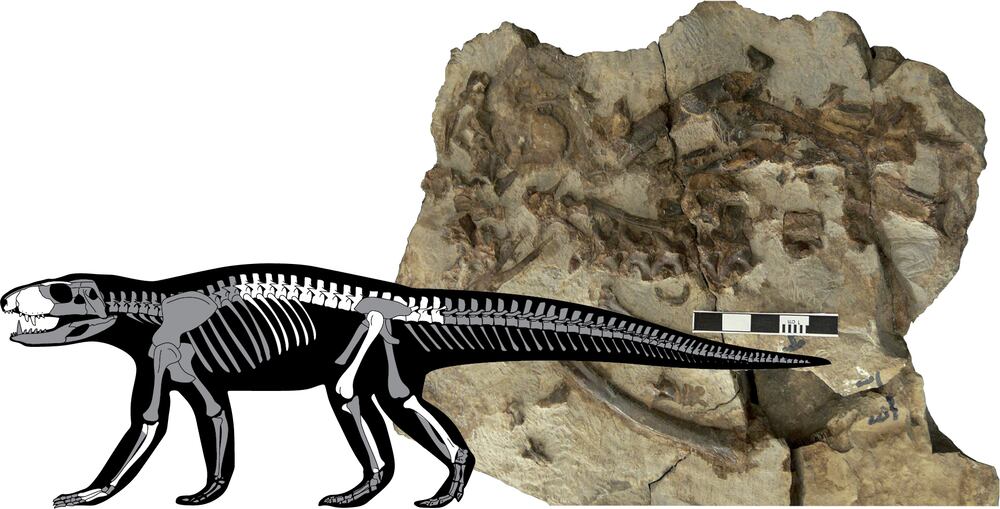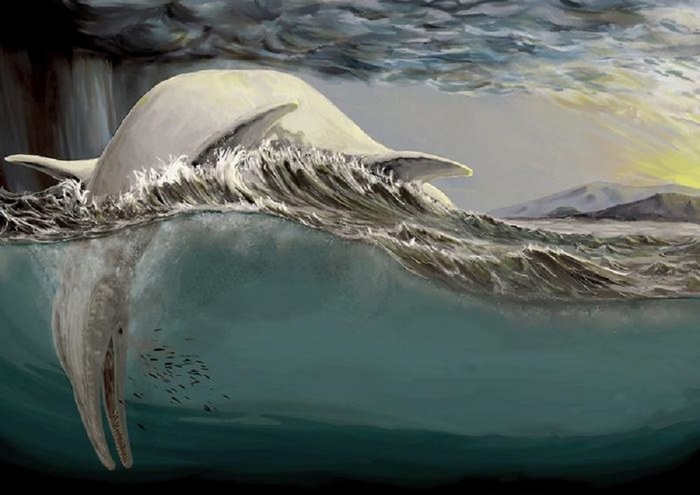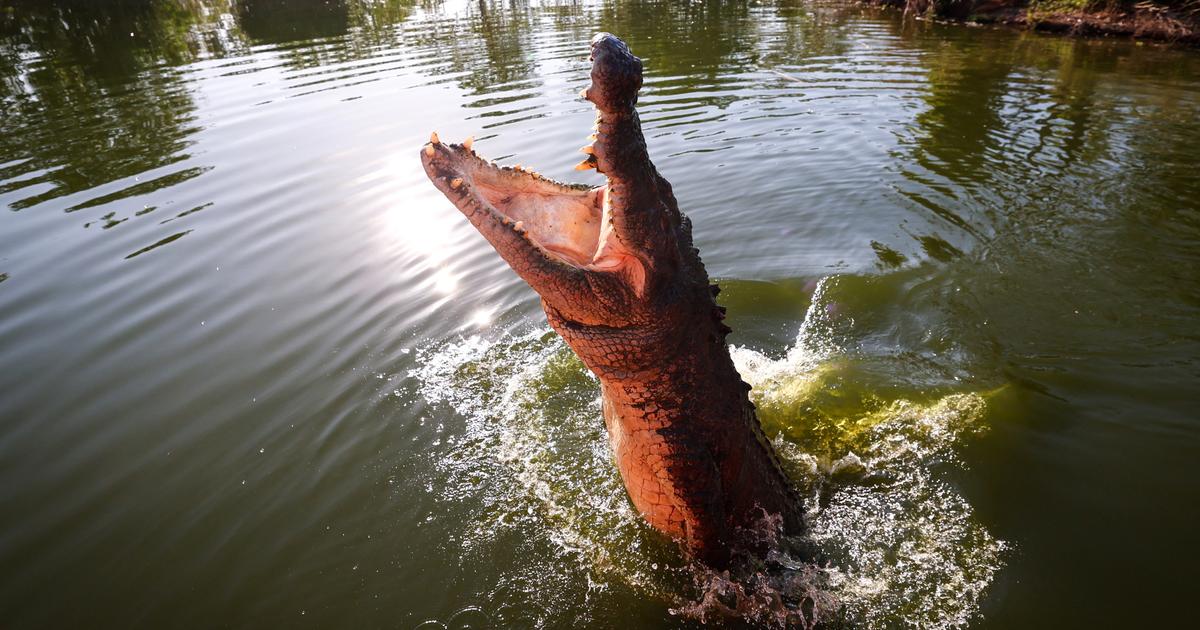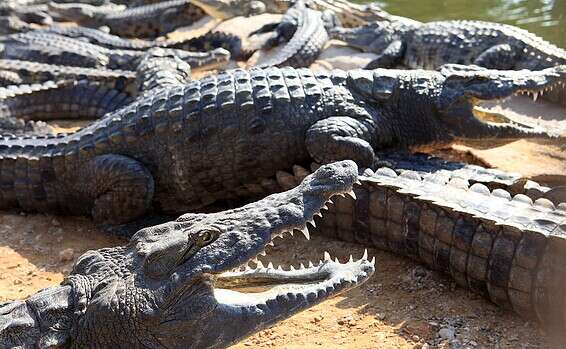In June 2013, researchers from the Catalan Institute of Paleontology received a call from a group of young people from Coll de Nargó, a small town in the Lleida Pyrenees, famous for hosting spectacular dinosaur sites in its land of reddish clay.
The inhabitants of the area, who by dint of finding fossils near their houses have learned to distinguish the rock from the bones, warned the scientists that there were remains of an unknown animal very close to a nest of titanosaur eggs.
The paleontologist Albert G. Sellés says that when he picked up the phone and heard the news, he was "stunned."
"The first thing I thought was that they had found a baby dinosaur," he says.
Excited with the idea, Sellés spoke with his team and the next day they went to the site of the discovery for a first inspection.
"We immediately realized that it was something else, an animal that we did not know."
The skeleton, Sellés says, was whole.
All bones were well preserved and in place.
The researchers asked permission to excavate and within days they returned to the site with chisels and hammers.
The paleontologist explains that an excavation like that can last approximately five days.
"We started on Monday and on Thursday we had almost the entire skeleton ready to extract, but it started to rain and with rain it is not recommended to remove anything from the earth, because the clay becomes softer, loses consistency and can affect the fossil."
Sellés decided to cover the skeleton with a special tarp to remove it the next morning.
The problem was that when he returned, the fossil was no longer there.
“I was responsible for removing the canvas.
I was stupid when I saw that there was nothing, "says the paleontologist.
The bones had disappeared.
All that remained were plaster marks in the dirt and wheel tracks from a strange van.
The researchers, experts in Mesozoic fauna, especially the dinosaurs that inhabited the northern part of the Iberian Peninsula 70 million years ago, called the Mossos d'Esquadra for help.
They cordoned off the area, investigated, collected evidence, spoke with witnesses, and determined that it had been a robbery.
The investigations to find the culprit lasted more than a month.
The thief, a 60-year-old resident of the town, returned the fossil in an "extremely sorry state," Sellés says.
The strange animal's bones were manipulated and broken.
"What at the beginning was a whole block was fragmented into seven or eight different pieces," the researcher laments, remembering the helplessness that he and his team felt during those days.
"We did not understand why someone would come to steal a skeleton that has no economic value."
Catalan law prohibits the sale and commercialization of these fossils, emphasizes the paleontologist.
The fossil was seized for two years while the legal process was resolved.
Once the custody ended, the skeleton finally reached the laboratories of the Catalan Institute of Paleontology.
It took almost two years for the researchers to repair it and, in 2017, they began to study its taxonomic and morphological characteristics in alliance with the Museo de la Conca Dellà, the University of A Coruña and the University of Barcelona.
The research findings, published last week in the journal
Scientific Reports
, reveal that the skeleton was of a small land crocodile unknown until now and named
Ogresuchus furatus
, which means “crocodile-ogre that was stolen”.
The new species is part of the sebecidae family, a lineage of land crocodiles abundant between the Paleocene and the Middle Miocene, between 66 and 15 million years ago.
According to Sellés, one of the most interesting aspects of the work is that the fossil is 71.5 million years old and represents the oldest specimen discovered.
"
Ogresuchus
is 10 million years older than any other sebaceous known to date, so the finding forces us to redefine the evolutionary history of this family," says the researcher.
The paleontologist Francisco Ortega, from the Evolutionary Biology group of the National University of Distance Education, affirms that the Coll de Nargó skeleton is a remarkably complete specimen that will serve to understand the behavior of this lineage of crocodiles in Europe.
“This land crocodile is perhaps the best characterized on our continent, because it has a complete neck, spine and tail, parts of the arm, legs and skull.
For the people who work in this field, it is an important discovery that helps to show what the evolutionary history of the group has been like ”, concludes Ortega.
The main characteristic of sebecidos is that, unlike current crocodiles, they had their legs located under the body.
"This anatomical peculiarity allowed them to move in a similar way to current mammals and to be very active predators," Sellés explains.
Another surprising aspect of this crocodile is its size.
“It was 80 centimeters long.
It was very tiny, compared to the other specimens of the sebecidae family found, for example, in southern Latin America, in Brazil and Argentina, which could reach four or five meters in length ”.
Sellés explains that all the evidence found suggests that the fossil was of an adult crocodile.
“We can know it from the fusion of its vertebrae, when an animal is young the vertebrae of the spine are not united.
When it grows, they fuse to give robustness and stability.
In our case they are like this, merged ”, he details.
The paleontologist Angela Delgado, from the Autonomous University of Madrid, acknowledges that it is a very interesting discovery to clarify "how these bugs got to Europe."
“This finding helps to confirm that the Iberian Peninsula acted as a connecting bridge between the southern and northern continents.
The interesting thing about the new crocodile is that it reveals that this connection was made many millions of years earlier than people believed ”.
Delgado affirms that the only criticism he has about the work is that the researchers "discard without justifying the relationship of
Ogresuchus
with another similar species from the same period called
Doratodon
.
"
“They don't study the similarities and differences, they name it in the introduction, but they dismiss it very quickly.
They leave the doubt open.
I am not saying that they are the same species, but it was an opportunity to reveal the relationship between one and the other, taking into account that they are of the same lineage and have similar morphological characteristics ”, he says.
Delgado, however, agrees with Sellés in recognizing that the fossil found in the fields of Coll de Nargó belongs to the oldest and smallest sebaceous crocodile and the first to reach the territory today known as Europe.
Three characteristics that make this finding one of the most relevant in recent years in this field.
The latest feature that surprised the researchers is that the crocodile skeleton appeared less than 50 centimeters from a nest of titanosaur eggs.
“The first thing we asked ourselves was how it got to that point.
We did a specialized study and the results showed that the animal died there, it was not transported by any river, but was left next to the nest, a step away, "says Sellés.
From this finding, a hypothesis is opened: this small carnivorous terrestrial reptile with teeth in the shape of a knife could feed on baby dinosaurs.
"An adult titanosaur is an animal that measured 15 meters in length, but its newborn babies were only 30 centimeters long, they were relatively easy prey to hunt for a predator like this," Sellés says.
Paleontologist Ortega, however, is a bit more skeptical on this point: "There could be some kind of biological relationship, but the research does not provide a very robust hypothesis because it is based only on a casual relationship."
You can follow
MATERIA
on
,
,
or subscribe here to our
newsletter
.









/cloudfront-eu-central-1.images.arcpublishing.com/prisa/2I75T5NCTFFJTDKNAD4SDRCYKM.jpg)